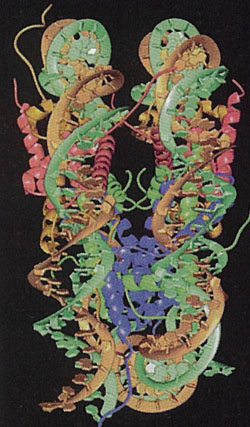DNA Need Not Unzip
When a cell’s DNA is damaged, its internal construction crew goes to work. The cell can use its “backup” copy of the genome as a template for repairs, but it needs to locate the correct region of the undamaged DNA. In the 16 April PRL a biophysics team proposes a new way that the search might work. According to their model, the surface charges on two side-by-side double helices create an attraction between the pair when their sequences are aligned. The theory is speculative and does not account for all of the complexities inside of real cells, but it does suggest a mechanism by which long sequences could find their mates–a process for which biologists have no solid explanation.
The genetic code consists of four molecular “letters,” or bases, whose sequence determines all genetic information. Pairs of bases form “steps” in the spiral staircase structure of DNA. If a section of DNA becomes damaged or lost, repair proteins help it locate the identical segment of DNA in the second copy of the genome that each cell contains. Biologists believe the proteins “unzip” the damaged double helix–separate it into two single strands, with bases exposed–before comparing the sequence with the other DNA copy.
But here is the mystery: To be sure that the correct location in the genome has been found, the segments must match almost exactly over a stretch of about 100 bases. Yet the protein-mediated process is best at recognizing a match of only about 10 or 20 bases and may not work at all for 100. Although researchers have proposed some mechanisms for recognition of longer stretches of DNA, the problem remains unsolved.
To address the problem, Alexei Kornyshev of the Jülich Research Center in Germany and Sergey Leikin of the National Institutes of Health in Bethesda, MD, modeled each DNA strand as a cylindrical core with both positively and negatively charged lines snaking around it in nearly helical patterns. But these helices were not perfect–the team built a function into their equations to represent the slight distortions caused by a sequence of non-identical bases. Kornyshev and Leikin then derived an equation for the attraction energy between two such DNA strands.
The team found that for 100- to 200-base-long strands with identical sequences, the attraction was about what was required–strong enough to overcome thermal jiggling, but not so strong that a “searching” segment would stick to a similar but incorrect stretch of the “target” DNA. If the two double helices had completely unrelated sequences, the attraction was too weak to overcome thermal energy. Identical strands attract because the alternating positive and negative charges along the cylinders line up exactly; if the sequences are unrelated, the positive and negative charges cannot align everywhere.
Leikin proposes that the damaged DNA in a cell finds its match by a two step processes: First, it locates a 100- to 200-base-long region that is perhaps 90% identical. Then the protein-mediated process binds tightly to a roughly 10-base-long stretch of perfectly matched DNA. Like zooming in on the best part of a microscope slide, “first you use a course grain mechanism, then fine tuning,” says Leikin.
“This is a clever idea, well-motivated by theory,” says Victor Bloomfield of the University of Minnesota in St. Paul. Bloomfield isn’t sure it will turn out to be correct–the effects the team studied may be overwhelmed by other effects in real cells–but “the attempt is certainly worth the effort.”



